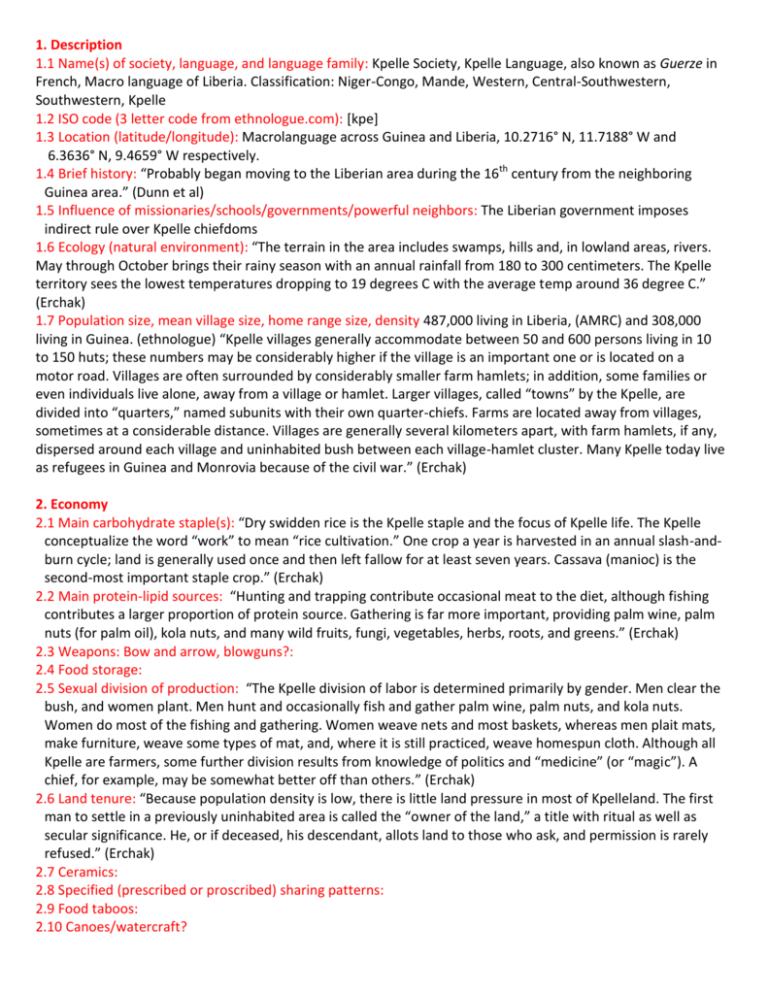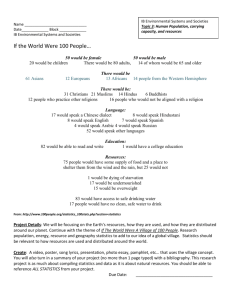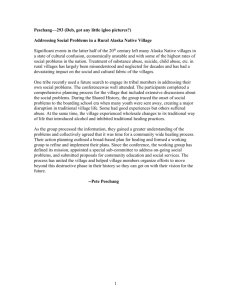
1. Description
1.1 Name(s) of society, language, and language family: Kpelle Society, Kpelle Language, also known as Guerze in
French, Macro language of Liberia. Classification: Niger-Congo, Mande, Western, Central-Southwestern,
Southwestern, Kpelle
1.2 ISO code (3 letter code from ethnologue.com): [kpe]
1.3 Location (latitude/longitude): Macrolanguage across Guinea and Liberia, 10.2716° N, 11.7188° W and
6.3636° N, 9.4659° W respectively.
1.4 Brief history: “Probably began moving to the Liberian area during the 16th century from the neighboring
Guinea area.” (Dunn et al)
1.5 Influence of missionaries/schools/governments/powerful neighbors: The Liberian government imposes
indirect rule over Kpelle chiefdoms
1.6 Ecology (natural environment): “The terrain in the area includes swamps, hills and, in lowland areas, rivers.
May through October brings their rainy season with an annual rainfall from 180 to 300 centimeters. The Kpelle
territory sees the lowest temperatures dropping to 19 degrees C with the average temp around 36 degree C.”
(Erchak)
1.7 Population size, mean village size, home range size, density 487,000 living in Liberia, (AMRC) and 308,000
living in Guinea. (ethnologue) “Kpelle villages generally accommodate between 50 and 600 persons living in 10
to 150 huts; these numbers may be considerably higher if the village is an important one or is located on a
motor road. Villages are often surrounded by considerably smaller farm hamlets; in addition, some families or
even individuals live alone, away from a village or hamlet. Larger villages, called “towns” by the Kpelle, are
divided into “quarters,” named subunits with their own quarter-chiefs. Farms are located away from villages,
sometimes at a considerable distance. Villages are generally several kilometers apart, with farm hamlets, if any,
dispersed around each village and uninhabited bush between each village-hamlet cluster. Many Kpelle today live
as refugees in Guinea and Monrovia because of the civil war.” (Erchak)
2. Economy
2.1 Main carbohydrate staple(s): “Dry swidden rice is the Kpelle staple and the focus of Kpelle life. The Kpelle
conceptualize the word “work” to mean “rice cultivation.” One crop a year is harvested in an annual slash-andburn cycle; land is generally used once and then left fallow for at least seven years. Cassava (manioc) is the
second-most important staple crop.” (Erchak)
2.2 Main protein-lipid sources: “Hunting and trapping contribute occasional meat to the diet, although fishing
contributes a larger proportion of protein source. Gathering is far more important, providing palm wine, palm
nuts (for palm oil), kola nuts, and many wild fruits, fungi, vegetables, herbs, roots, and greens.” (Erchak)
2.3 Weapons: Bow and arrow, blowguns?:
2.4 Food storage:
2.5 Sexual division of production: “The Kpelle division of labor is determined primarily by gender. Men clear the
bush, and women plant. Men hunt and occasionally fish and gather palm wine, palm nuts, and kola nuts.
Women do most of the fishing and gathering. Women weave nets and most baskets, whereas men plait mats,
make furniture, weave some types of mat, and, where it is still practiced, weave homespun cloth. Although all
Kpelle are farmers, some further division results from knowledge of politics and “medicine” (or “magic”). A
chief, for example, may be somewhat better off than others.” (Erchak)
2.6 Land tenure: “Because population density is low, there is little land pressure in most of Kpelleland. The first
man to settle in a previously uninhabited area is called the “owner of the land,” a title with ritual as well as
secular significance. He, or if deceased, his descendant, allots land to those who ask, and permission is rarely
refused.” (Erchak)
2.7 Ceramics:
2.8 Specified (prescribed or proscribed) sharing patterns:
2.9 Food taboos:
2.10 Canoes/watercraft?
3. Anthropometry
3.1 Mean adult height (m and f):
3.2 Mean adult weight (m and f):
4. Life History, mating, marriage
4.1 Age at menarche (f):
4.2 Age at first birth (m and f):
4.3 Completed family size (m and f): “Apart from compound families of polygynists, the normal residential group
is the elementary family; married sons and daughters, even if they live in the same village, invariably have their
own households.” (Gibbs) “The polygynous family, with each wife and her children having their own hut, is the
ideal form, but it is quite rare. It is more likely that all members of a polygynous family live in the same house,
with each wife having her own room. Often one wife will live elsewhere, even several kilometers away.
Monogamous nuclear and extended families are on the increase.” (Erchak)
4.4 Inter-birth-interval (f):
4.5 Age first marriage (m and f):
4.6 Proportion of marriages ending in divorce: “At least 20 percent of Kpelle marriages end in divorce, which can
be quite complex and protracted. Grounds include infertility and adultery for husbands, and physical abuse and
nonsupport for wives. Divorce negotiations involve property, especially when substantial bride-price is
involved.” (Erchak)
4.7 Percent marriages polygynous, percent males married polygynously: “Although monogamy has become
more common in the late twentieth century, polygyny remains the preferred marital type.” (Erchak)
4.8 Bride purchase (price), bride service, dowry?: “Anthropologist James Gibbs (1965) describes six types of
union recognized by the Kpelle, ranging from the most prestigious (full bride-price paid outright with patrilocal
residence) to casual liaisons. The Kpelle prefer marriage with bride-price, although bride-service is acceptable
as well. Patrilocal postmarital residence is preferred, but neolocality associated with bride-service is quite
common for very young couples.” (Erchak)
4.9 Inheritance patterns: “A man's authority, property, and younger wives are inherited either by his oldest
surviving brother or his oldest son. Obligations, debts, personality, and food taboos, among other things, are
inherited patrilineally.” (Erchak)
4.10 Parent-offspring interactions and conflict: Married children often leave the home to establish their own
households, but occasionally if they are to stay with their parents after marriage, they would live with the
man’s mother. (Erchak)
4.11 Homosexual activities, social attitudes towards homosexuals:
4.12 Pattern of exogamy (endogamy):
4.13 What is the belief of the role of males in conception; is paternity partible? Are these “other fathers”
recognized? Paternity is not partible.
4.14 What is the belief of the mother’s role in procreation exactly? (e.g., “receptacle in which fetus grows”)
4.15 Is conception believed to be an incremental process (i.e., semen builds up over time)?
4.16 Occurrence of sexual coercion, rape
4.17 Preferential category for spouse (e.g., cross cousin) No preference, in group or out of group. (Erchak)
4.18 Do females enjoy sexual freedoms? Yes, but only when they have not been paid for by a groom are women
able to engage in loose sexual relationships. (Gibbs)
4.19 Evidence of giving gifts to extramarital partners or extramarital offspring
4.20 If mother dies, whose raises children? The father’s mother. (Bellman)
4.21 Adult sex ratio: number of adult males divided by number of (reproductive) females
4.22 Evidence for couvades No
4.23 Different distinctions for potential fathers (e.g., lesser/younger vs. major/older)
4.24 Kin avoidance and respect?
4.24 Joking relationships? Yes, but a man cannot be joking around with the women of his family.
4.25 Patterns of descent (e.g., bilateral, matrilineal) for certain rights, names or associations “A man's authority,
property, and younger wives are inherited either by his oldest surviving brother or his oldest son. Obligations,
debts, personality, and food taboos, among other things, are inherited patrilineally.” (Erchak)
4.26 Incest avoidance rules “A man may not marry or make sexual jokes with a woman who has the same last
name.” (Gibbs)
4.27 Is there a formal marriage ceremony? Yes.
4.28 In what way(s) does one get a name, change their name, and obtain another name?
4.29 Is marriage usually (or preferred to be) within community or outside community? (m/f difference?) “The
band itself, as a structured unit, is not a factor in regulating marriage. People may marry within their bands or
without them if relationships permit” (Gibbs)
4.30 Are marriages arranged? Who arranges (e.g., parents, close kin)?
4.31 Evidence for conflict of interest over who marries who:
Warfare/homicide
4.14 Percent adult (male) deaths due to warfare:
4.15 Outgroup vs ingroup cause of violent death:
4.16 Reported causes of in-group and out-group killing: “The Kpelle engaged in sporadic warfare until the late
1930s.” (Erchak)
The Kpelle coordinate open warfare between villages through the leaderships of the villages respective Poro
leaderships. Battles are rare, but when fought are over territorial disputes. (Bellman)
4.17 Number, diversity and relationship with neighboring societies (external relations): “The Kpelle interact most
frequently with the neighboring Mende, Loma, Mano, and Bassa. They share the Poro complex of secret ritual
societies with all of these peoples except the Bassa; initiates may even attend certain secret rituals in these
other ethnic areas. The Kpelle also trade with the Muslim Vai and Mandingo, who frequently live among them
in small numbers, as do some Lebanese merchants and U.S. missionaries and Peace Corps volunteers. An
Episcopal-controlled four-year college is located in the middle of Kpelleland.” (Erchak)
4.18 Cannibalism? No
5. Socio-Political organization and interaction
5.1 Mean local residential (village) group size: 50-150 people (see population density above)
5.2 Mobility pattern: (seasonality): Permanent (Agricultural)
5.3 Political system: (chiefs, clans etc, wealth or status classes): “The structure of the Kpelle court system
parallels that of the political organization. In Liberia the highest court of a tribal authority and the highest tribal
court chartered by the Government is that of a paramount chief. A district chief's court is also an official court.
Disputes may be settled in these official courts or in unofficial courts, such as those of town chiefs or quarter
elders. In addition to this, grievances are settled informally in moots, and sometimes by associational
groupings such as church counsels or cooperative work groups.” (Podolefsky, and Brown)
5.4 Post marital residence: “Patrilocal postmarital residence is preferred, but neolocality associated with brideservice is quite common for very young couples.” (Erchak)
5.5 Territoriality? (defined boundaries, active defense): See land tenure (2.6)
5.6 Social interaction divisions ? (age and sex):
5.7 Special friendships/joking relationships:
5.8 Village and house organization:
5.9 Specialized village structures (mens’ houses):
5.10 Sleep in hammocks or on ground or elsewhere? Ground
5.11 Social organization, clans, moieties, lineages, etc: The secret societies of the Poro and Sande, respectively
male and female, are far-reaching socio-political organizations all along the Ivory Coast. Although the
organizations are fairly wide spread, the secrecy makes them not well integrated with one-another. The
association of members therefore relies not on membership in a group, but on interactional context.
5.12 Trade: “Markets were introduced by the Americo-Liberians and are still not found in remote roadless parts
of Kpelleland, but, in less remote areas, lively weekly markets are an important event. In large commercial
towns lining the major arteries, one may find market produce nearly every day, in addition to many Lebaneseand Syrian-run shops.” (Erchak)
5.13 Indications of social hierarchies?
6. Ritual/Ceremony/Religion (RCR)
6.0 Time allocation to RCR:
6.1 Specialization (shamans and medicine): “Medicine men, medicine women, and shamans of various types also
often enjoy considerable prestige and influence, particularly within the framework of the numerous secret (or
sacred) societies. The blacksmith, for example, is always a powerful medicine man who is believed by many to
be an important ritual leader within the Poro society for men. Wealthy, influential men are called “outstanding
men” or “big shots” and are very much admired and often envied.” (Erchak)
6.2 Stimulants:
6.3 Passage rituals (birth, death, puberty, seasonal): “Poro: A male sodality found among several groups in
central and western Liberia, including the Vai, Gola, Dei, Mende, Bande, Loma, Kpelle and part of the Ma. The
society serves two primary functions. It is the main institution to enculteurate young males and to formally
carry them through the rite of passage from child to adult. In addition, the elders of the Poro serve as the
intermediaries between the ancestors and the living, and thus act as the ultimate arbiters of asocial actions
which affect the society. The female counterpart of this organization is the Sande society. The main function of
the Sande is to serve as an enculterative institution and to make the transition of girls into women. The Sande
sessions in the past have lasted for three years.” (Dunn et al)
6.4 Other rituals: “Sacrifices are made to ancestors and other spirits, often at crossroads. Rituals and ritual
knowledge are secret and, in general, associated with the secret medicine societies. Accordingly, most
important Kpelle rituals are not accessible to observers. One exception is the coming-out ceremonies following
initiatory seclusion.” (Erchak)
6.5 Myths (Creation):
6.6 Cultural material (art, music, games): “The Kpelle design various musical instruments, weave homespun
cloth and several types of mat, and carve crude sculptures. Their most beautiful and refined artistic creations
are the elegant and awesome spirit masks associated with the secret societies.” (Erchak)
6.7 Sex differences in RCR: “The Kpelle recognize three principal types of shaman (medicine person of either
sex): those associated with the Poro and Sande societies, those associated with other specific medicine
societies, and those who are independent. The first two types mainly conduct rituals; the third type, and
occasionally the second, primarily heal. The Kpelle also utilize diviners who analyze problems for a fee.”
6.8 Missionary effect: “Whereas some 10 to 25 percent of the Kpelle are nominal Christians (usually Lutheran) in
those areas where missionaries are very active, and whereas a handful embrace Islam, the vast majority hold
traditional animistic beliefs.” (Erchak)
6.9 RCR revival:
6.10 Death and afterlife beliefs: “Death is a passing into a spiritual realm that coexists with the material realm.
The deceased become ancestors, who seem to become increasingly vague and to move further away from
villages and into the bush as their memory becomes less distinct in the minds of their living relatives.” (Erchak)
6.11 Taboo of naming dead people? No
6.12 Is there teknonymy? No
6.13 Briefly describe religion (animism, ancestor worship, deism, magic, totems etc.) “Kpelle religion is rather
inchoate, focused vaguely on God, the ancestors, and forest spirits and more sharply on the secret medicine
societies and the masked spirits who operate within those societies. The Kpelle recognize a High God who
created the world and then retired. They believe in a variety of lesser spirits or genii, including ancestors,
personal totems, water spirits, and spirits in magically powerful masks. Witchcraft and sorcery figure
prominently in the belief system.” (Erchak)
7. Adornment
7.1 Body paint:
7.2 Piercings:
7.3 Haircut:
7.4 Scarification:
7.5 Adornment (beads, feathers, lip plates, etc.):
7.6 Ceremonial/Ritual adornment: Medicine men, moderators carry a big stick (kpung) to wave around and look
official (Podolefsky)
7.7 Sex differences in adornment:
7.8 Missionary effect: The culture of clothing has been affected less by missionaries and more by the fact that
the Kpelle inhabit Liberia, so there is a very large western influence there.
7.9 Cultural revival in adornment:
8. Kinship systems
8.1 Sibling classification system:
8.2 Sororate, levirate: It is not unusual for a man to be married to two women who are sisters, but the death of a
woman does not necessitate the presence of the sister to fulfill the role.
8.3 Other notable kinship typology, especially cross-cousin (MBD/FZD) typology (Crow/Hawaiian/Omaha etc.):
“Iroquois cousin terminology with bifurcate-merging avuncular terms is used.” (Erchak)
9. Other interesting cultural features (list them):
The Kpelle Moot. The judicial system of the Kpelle is organized in two ways: one by a person who would want to
make a complaint. Everyone involved and close relatives assemble at a house and an elder from the Poro
(kpung holder) would mediate a discussion about it. The focus of the ceremony is to restore group harmony
and the kpung holder performs many blessings throughout the meeting, ending the discussion acting that
everyone please act with good grace and unity. The end result normally is a group catharsis as everyone
present is able to speak their minds in turn. The second part, the more official part is the court system, which is
headed by the village chief and models the Liberian government. “The court is particularly effective in settling
cases such as assault, possession of illegal charms, or theft where the litigants are not linked in a relationship
which must continue after the trial” and the court is markedly coercive and abusive. (Podolefsky)
Numbered references
1. Dunn, D. Elwood, Amos J. Beyan, et al. Historical Dictionary of Liberia. Second. Lanham, Maryland: The
Scarecrow Press, Inc., 2001. Print.
2. Dunn, D. Elwood, and S. Byron Tarr. Liberia: A National Polity in Transition. First. Metuchen, New Jersey:
The Scarecrow Press, Inc., 1988. Print.
3. Bellman, Beryll L. The Language of Secrecy. First. New Brunswick, New Jersey: Rutgers University Press,
1984. Print.
4. Lancey, David E. Playing on the Motherground. First. New York: The Guilford Press, Inc., 1996. Print.
5. Stakeman, Randalf. The Cultural Politics of Religious Change. Lewiston, New York: The Edwin Press, 1986.
Print.
6. Erchak, Gerald M. "Kpelle." Encyclopedia of World Cultures. Macmillan, 1998. Web. 23 Apr 2012.
<http://www.sscnet.ucla.edu/anthro/faculty/fiske/135b/kpelle.htm>.
7. AMRC. "The Kpelle of Liberia." Africa Missions Resource Center. virtuosoonline, 2003. Web. 23 Apr 2012.
<http://www.africamissions.org/africa/fskpelle.html>.
8. Gibbs, James L., Jr. (1965). “The Kpelle of Liberia.” In Peoples of Africa, edited by James L. Gibbs, Jr., 197240. New York: Holt, Rinehart & Winston.
9. Podolefsky, Aaron, and Peter J. Brown. "The Kpelle Moot." Applying Anthropology, an Introductory
Reader. 33.1 (1963): n. page. Web. 23 Apr. 2012. <http://www.afn.org/~afn54735/anthro1.html>.










